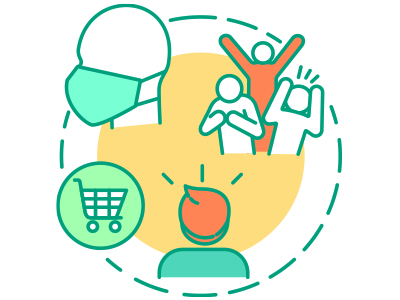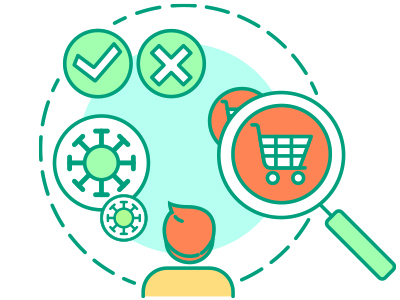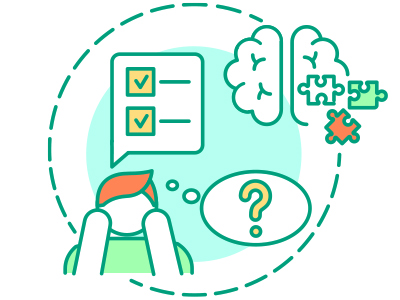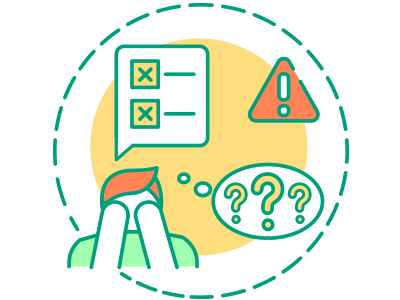Living with anxiety during a global pandemic
Reprinted from the COVID-19 issue of Visions Journal, 15 (2), pp. 24-27

Life is always full of uncertainty, but the COVID-19 pandemic is new territory for most people in British Columbia. The pandemic creates uncertainty as people become sick or wonder if they’ll catch the virus. Many people have lost their job or have had to change jobs. Access to services and programs like health supports has changed. Loved ones were separated as borders closed. All of these uncertainties make us more anxious than usual.
While uncertainty may be uncomfortable or unpleasant, we can manage some of our anxiety and worry by following some simple guidelines.
 Find balance in media exposure and think critically about COVID-19 information
Find balance in media exposure and think critically about COVID-19 information
It’s important to stay informed. Good information can help us evaluate risks and understand what we can do to stay healthy. However, too much news and social media can be harmful. When we focus on something, we’re more likely to spend a lot of time thinking about it. When we spend too much time thinking about the pandemic, COVID-19 may feel riskier and scarier than it really is. It’s important to find a reasonable balance. For example, we can commit to checking the news only a couple of times in a day; we can make ourselves a media schedule so we don’t have to fight the urge to look for updates. We can disable news and social media alerts on our phone so we can control when we receive updates.
There’s a lot of inaccurate information out there. Particularly on social media, a raft of “overnight experts” on virology and epidemiology are sharing their opinions, even when they aren’t qualified to speak about a particular subject. It’s important to access reputable sources and to critically evaluate the information we receive.
- For reliable information about COVID-19, visit cmha.bc.ca/covid-19-stay-informed/finding-reliable-information
- For more on how to critically evaluate health information, see cmha.bc.ca/covid-19-stay-informed/thinking-critically-about-health-information
 Understanding risk
Understanding risk
While we are all experiencing the same pandemic, we each have different risks to consider. Some people have a higher risk of complications if they become sick, or they may live with someone who is at higher risk. If we are concerned, we should talk to our health care provider and seek out accurate information so we understand what our risks actually look like.
Avoiding things we find scary or anxiety-provoking in order to reduce risk can make sense in the short term, but in many cases, avoiding situations can sustain and strengthen our anxiety. As we work to overcome anxiety, we learn two things:
- We often overestimate the likelihood or risk of something bad happening
- We often underestimate how well we can cope in the event that something bad does happen
 Confronting anxiety
Confronting anxiety
Putting ourselves in situations that bring on anxiety may not seem logical, but it is frequently exactly what we need to do. To confront anxiety safely, take the following steps:
1. Continue to follow public health recommendations

Challenging anxiety does not mean we should put ourselves in dangerous situations. We should still keep our contact groups small, maintain physical distancing, wear a mask when it’s requested and stay home when we feel unwell. We should avoid touching our face and continue to wash our hands frequently.
2. Identify fears and beliefs and challenge them before confronting them

The anxious part of our brain will say things like Don’t do this: it could be risky, or What if you contract the virus and bring it back to your family? In response, we can identify the specific fears behind those thoughts. For example, the specific fear behind What if it’s dangerous? might be I’m afraid that if I go to the grocery store, I’ll catch COVID-19.
For tips on how to identify and challenge more complex fears, visit anxietycanada.com/articles/challenge-negative-thinking.
3. Start actively confronting the fear by doing the thing we’ve been avoiding

If we’ve avoided certain situations for a while, it may be harder to do the things that used to be easy. We should start with small goals and slowly work our way towards larger goals. We want to give ourselves a chance to succeed; as our confidence increases, so does our motivation to keep going. For example, if we’ve avoided going to the grocery store and the thought of setting foot in one is too anxiety-provoking, we can set ourselves the goal of walking towards the entrance. Eventually, we can work our way up to walking inside the grocery store and buying a few items. If we complete the smaller, less anxiety-provoking steps first, then contemplating—and eventually taking—bigger steps is more manageable.
Another example involves anxiety related to seeing other people in person again. We can begin by identifying people we’d like to have in our “COVID-19 bubble” and start seeing them outside for a physically distanced walk. We can follow this up with an outdoor picnic, with the end goal of allowing ourselves to be indoors with the people we’ve chosen (when public health orders allow).
For guidance on doing these sorts of exposure exercises, visit anxietycanada.com/articles/helpful-tips-for-doing-exposure-exercises.
4. Test fears thoroughly

Often when people first try to get past a fear, the situations in which they challenge their fear are limited (for example, we may go to the grocery store only in the morning when it’s less busy). This doesn’t provide us with much evidence with which to challenge and dispute our fears. To gather more useful information, we should vary the challenge and the situation.
When possible, we can even combine situations that make us anxious. For example, we could take public transit to the grocery store at a different time of day. The more we challenge our fears, the faster our anxiety will subside.
5. Reflect and debrief after confronting feared or avoided situations.

After we’ve challenged a fear or anxiety, we can reflect on our experience. What did I think was going to happen before and after I faced that feared situation? What were the differences between my anticipation and the reality? If there is a time delay between challenging our fear and experiencing the result of that challenge (for example, COVID-19’s possible 14-day incubation period), we can set a reminder on our phone for two weeks after we engaged in the challenge. When our phone alarm goes off two weeks after we went to the grocery store, we can take the time to reflect on the outcome.
6. Don’t come up with reasons why a feared outcome didn’t happen.

When we face our fears and confront the situations we’ve been avoiding, our brains will start to come up with excuses, or reasons why a feared outcome didn’t materialize: I just got lucky, or Everyone in the store was healthy. It’s possible some of these statements are true, but if we continuously try to minimize the success of the outcome, we’ll learn to never see the evidence and positive data as legitimate. The more data we collect, the more accurately we can test the belief that’s causing so much anxiety.
 Have compassion for ourselves and others
Have compassion for ourselves and others
Facing fears is no easy task. On some days, we may feel like we aren’t making much progress, or even that we’re going backwards. On those days, we should remind ourselves that we’re trying to do something that is difficult and that we’re doing the best we can. We can’t compare our current levels of motivation, willingness or productivity to what we were able to do before the pandemic hit.
We all have different experiences with COVID-19 and different relationships with anxiety. Comparing our experiences to other people’s experiences—or what we perceive to be their experiences—isn’t useful. We must each work at our own pace and congratulate ourselves for working hard.
We must also reach out and ask for support from others if we’re struggling. Can’t go to that store alone? Ask a friend to go instead. Worried about leaving the house but aren’t ready to bring someone? Call the person and talk to them.
Offering support to others can have surprising personal benefits where anxiety is concerned. If we are concerned about an elderly neighbour or a disabled or immunocompromised individual, we can call them and ask them if they need anything. Focusing on helping others makes overcoming our own anxiety easier.
 Opportunity in anxiety
Opportunity in anxiety
At the end of the day, the human experience of anxiety is a stress response designed to protect us. The worry we’re experiencing now is activating the primitive parts of our brain that help us avoid danger; it is understandable that we avoid situations in order to keep ourselves safe. But in some circumstances, avoidance doesn’t necessarily keep us safe; it simply gives us the illusion of control. The cost of sustaining this illusion is high: it has a negative impact on the quality of our life.
As human beings, we all tolerate uncertainty differently from each other. But if we continue to accept our reactions to our anxious thoughts rather than challenge the anxious thoughts themselves, then the power of anxiety to imprison us in an increasingly smaller box grows over time. During the COVID-19 pandemic, learning how to safely follow public health guidelines while challenging our personal anxieties will enable us to live the life that we aspire to, despite the uncertainty that lies ahead.
Some of the recent losses in our lives are not due to COVID-19-related anxiety, but to the fact that some activities were deemed too risky and were cancelled altogether. The weekly soccer practice, trivia night with friends, concerts—all of these are losses. We can’t fight our way out of these losses; all we can do is feel their impact. It’s important that we acknowledge that grief and loss are experiences that need to be processed; we can use the opportunity to see what new activities or routines we can adopt to replace the ones no longer available to us.
Today, it’s a pandemic; next month or next year, we may face an entirely different, seemingly life-threatening challenge. Consider the pandemic as an opportunity to stop thinking about the countless “what ifs” and to focus on what we gain if we’re not restricted by what we cannot control.
Related ResourcesFor more information and resources on coping with anxiety in the context of COVID-19, visit Anxiety Canada at anxietycanada.com/covid-19, HereToHelp at heretohelp.bc.ca and CMHA BC at cmha.bc.ca/covid-19. |
About the author
Mark is a registered clinical counsellor who works as Anxiety Canada’s in-house anxiety management expert. He also practises out of the Vancouver CBT Centre, where he treats individuals with anxiety spectrum disorders. Mark’s formal training includes the treatment of anxiety with primarily adult populations, using cognitive-behavioural therapy in numerous settings
Stephanie is Editorial Coordinator for the Canadian Mental Health Association BC Division, where she has authored hundreds of plain-language mental health and substance use health literacy educational products and resources over the past 11 years, including the content on CMHA’s COVID-19 microsite

